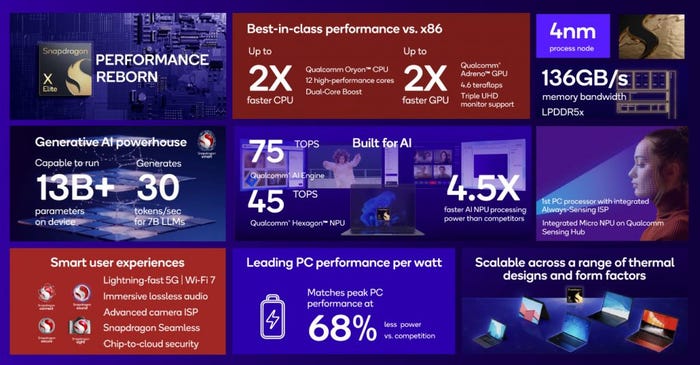Qualcomm launches AI-fuelled assault on the PC marketQualcomm launches AI-fuelled assault on the PC market
Intel and AMD's PC party has just been gate-crashed by a late arrival that has the potential to radically alter the mood.
October 24, 2023

Intel and AMD’s PC party has just been gate-crashed by a late arrival that has the potential to radically alter the mood.
US chip giant Qualcomm has used its annual showcase in Hawaii to formally unveil its hotly-anticipated Snapdragon X Elite, its first dedicated, high-end PC chipset. Based on custom Arm architecture, called Oryon, Qualcomm claims it offers a 2x improvement in processing speed compared to x86 – i.e. Intel and AMD – CPUs, and 2x the on-board graphics processing power – all with better battery life.
But it’s the on-device AI capabilities that Qualcomm is really keen to emphasise.
Snapdragon X Elite can run large language models with over 13 billion parameters, and process 30 tokens – a sort of currency that users pay to run queries on an LLM – every second, taking the capabilities of cutting-edge generative AI tools out of the cloud and onto devices.
“Snapdragon X Elite represents a dramatic leap in innovation for computing as we deliver our new, custom Qualcomm Oryon CPU for super-charged performance that will delight consumers with incredible power efficiency and take their creativity and productivity to the next level,” said Kedar Kondap, SVP and general manager of compute and gaming at Qualcomm. “Powerful on-device AI experiences will enable seamless multitasking and new intuitive user experiences, empowering consumers and businesses alike to create and accomplish more.”
Qualcomm-powered PCs are expected to hit the market in the middle of next year, and it will be interesting to see how the old guard responds. The company’s entry into PCs draws heavily on its heritage as the world’s foremost vendor of mobile chipsets, and the launch of Snapdragon X Elite is by no means a sign that Qualcomm has taken its eye off the handset market.

Unveiled alongside its new PC portfolio is Qualcomm’s latest mobile chipset, the Snapdragon 8 Gen 3. Like Snapdragon X Elite, it packs in as much AI tech as possible, with on-device support for 10 billion-parameter LLMs and the ability to process 15 tokens per second.
It comes with built-in support for AI assistants powered by Facebook parent Meta’s Llama 2 LLM. It can interpret text, voice and image inputs and respond intelligently to them, or use them to create content, including images and even social media posts.
“This platform unlocks a new era of generative AI enabling users to generate unique content, help with productivity, and other breakthrough use cases.” said Chris Patrick, SVP and general manager of mobile handsets, Qualcomm. “Each year, we set out to design leading features and technologies that will power our latest Snapdragon 8-series mobile platform and the next generation of flagship Android devices. The Snapdragon 8 Gen 3 delivers.”
Gen AI has also been embedded into Snapdragon 8 Gen 3’s video and image-capturing technology. It enables voice-activated picture and video editing, and includes a photo expansion feature, which intuitively extends an image beyond what was in the frame.
As expected, the new processor also packs in the last word in graphics processing and audio streaming technology. Snapdragon 8 Gen 3 also supports Wi-Fi 7.
Understandably, smartphone OEMs are lining up to launch products powered by the new processor. Qualcomm said ASUS, Honor, iQOO, MEIZU, NIO, Nubia, OnePlus, OPPO, realme, Redmi, RedMagic, Sony, vivo, Xiaomi, and ZTE all plan to use it in their upcoming flagship devices. The first ones are expected to hit the shelves in the coming weeks.
As well as processors, Qualcomm also showed off its latest audio chipset, the S7 and S7 Pro Gen 1 platforms, which – you guessed it – use AI to improve noise cancellation.
It also unveiled Snapdragon Seamless, a cross-platform technology that enables users to link electronic devices – irrespective of their operating system – and get them working together as one.
In practice, it means that PC peripherals like mice and keyboards will work with smartphones and tablets; Bluetooth earbuds can switch automatically between devices based on the priority of the audio source; and it also supports screen and file-sharing between different devices.
“Snapdragon Seamless fundamentally breaks down the barriers between OEMs, devices and operating systems. It’s the only cross-device system to truly put the user first,” said Dino Bekis, VP and GM, wearables and mixed signal solutions, Qualcomm.
Support for Snapdragon Seamless is baked into the new X Elite and Snapdragon 8 Gen 3 processors, as well as its audio chipset, and Qualcomm plans to add support for automotive and IoT platforms further down the line. So far, Xiaomi, Honor, Lenovo, Microsoft and OPPO, among others, have all signed up to use Snapdragon Seamless, with a view to launching supporting products as early as this year.
It was the one announcement that didn’t bang the AI drum too loudly, if anything offering a welcome respite from it all.
Indeed, generative AI has been the hottest topic of 2023, and the potential downside of this relentless torrent of AI-related announcements from every corner of the tech industry is that people could tire of hearing about it before it’s even got going properly.
However, Qualcomm putting the power of AI onto devices promises to change how we interact with them, and paves the way for handset OEMs to offer some genuinely innovative – and much needed – new experiences.
Get the latest news straight to your inbox. Register for the Telecoms.com newsletter here.
About the Author
You May Also Like










.png?width=300&auto=webp&quality=80&disable=upscale)


_1.jpg?width=300&auto=webp&quality=80&disable=upscale)